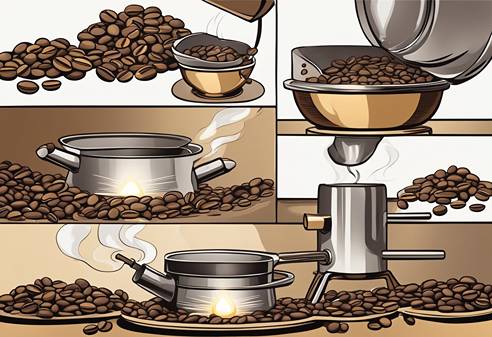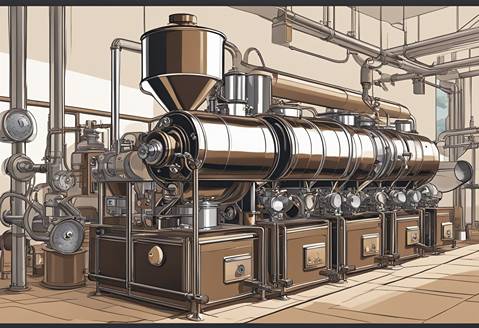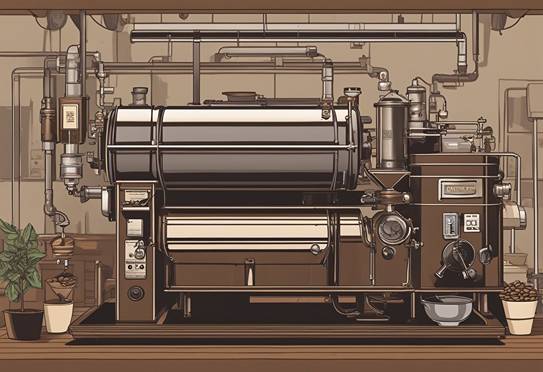Torrefaction coffee is a unique method of roasting coffee beans that has its roots in 19th century Spain.
The process involves adding sugar to the beans during roasting, resulting in a glazed, caramelized coating that enhances the flavor and aroma of the final product.
Torrefacto coffee was originally developed to increase the shelf life of coffee beans by protecting them against moisture, mold, and other forms of spoilage.

The torrefaction process brings out the inherent qualities of the coffee beans, creating a richer, more complex taste profile compared to traditional roasting methods.
This distinctive caramelized flavor might take some getting used to, but many coffee aficionados appreciate the novelty and depth of flavor that torrefaction coffee offers.
Key Takeaways
- Torrefaction coffee is a unique roasting method that originated in Spain and involves adding sugar to the beans during roasting.
- The sugar coating on torrefacto beans enhances flavor and aroma while increasing their shelf life.
- Torrefacto coffee offers a richer, more complex taste profile compared to traditional roasting methods.
Torrefaction Basics

Defining Torrefaction
Torrefaction is a process used in coffee roasting where sugar is added to the beans during the final stage of the roast.
This results in a caramelized glaze coating the beans, enhancing their flavor and aroma. It accounts for about 10% to 20% of the total weight of the coffee being made.
There are three levels of coffee roasts: light, medium, and dark, with torrefaction typically applied to the dark roast.
When done correctly, you can expect a richer, more complex taste profile and distinct aromas in your cup of torrefacto coffee.
History of Torrefacto Coffee
The practice of torrefaction in coffee production originated in Spain and Portugal.
Torrefacto coffee has been a staple in these countries since the early 20th century, though its popularity has waned in recent years.
In Spain, the tradition of using sugar in coffee roasting dates back to the Spanish Civil War in the 1930s when coffee was scarce, and sugar was added to preserve and stretch the supply of beans.
The resulting coffee had a longer shelf life, and the sugar masked the taste of low-quality beans.
To make torrefacto coffee, here is a brief step-by-step process:
- Preheat your coffee roaster to the desired roasting temperature.
- Add the green coffee beans to the roaster.
- During the final stages of roasting, gradually add sugar (about 10% to 20% of the total amount of coffee).
- The sugar caramelizes and forms a glaze on the beans.
- Remove the beans from the roaster and allow them to cool.
In conclusion, torrefaction is a distinctive roasting technique that enhances the flavor and aroma of coffee beans while offering some historical context.
While this method may not be as common today, it remains an interesting part of coffee history, particularly in Spain and Portugal.
So, if you ever have the opportunity to try torrefacto coffee, you’ll be able to appreciate the unique taste and the story behind the tradition.
What is Torrefaction Coffee Process?

From Green to Brown
The torrefaction process begins with green coffee beans, which are then subjected to heat.
The heating process transforms these green beans into the familiar brown beans that you use to prepare your coffee.
This transformation occurs at a lower temperature and for a longer duration than traditional roasting methods, resulting in a unique flavor profile.
The Role of Sugar in Torrefaction
An essential aspect of the torrefaction process is the addition of sugar during the final stages of roasting.
The sugar content can be quite significant, making up about 20% of the final product.
This added sugar caramelizes during roasting, forming a glaze on the coffee beans.
The resulting product is referred to as torrefacto or glazed coffee and is particularly popular in countries such as Spain, Portugal, and France.
Chemical Reactions During Roasting
During the torrefaction process, several chemical reactions occur to create complex flavors and aromas in the roasted beans.
One critical reaction is the Maillard reaction, which is responsible for the characteristic brown color, aroma, and taste.
The Maillard reaction is a chemical reaction between amino acids and reducing sugars that occurs when food is heated.
In the context of coffee, this reaction leads to the formation of different molecules responsible for the enticing aroma and appealing flavors of the brewed beverage.
The additional sugar content introduced during torrefaction amplifies these chemical reactions, enhancing caramelization and the development of unique flavor profiles.
In summary, the torrefaction process consists of heating green coffee beans at a lower temperature for an extended duration.
The addition of sugar during roasting plays a significant role in developing the distinctive flavor and aroma characteristics, due to enhanced caramelization and chemical reactions such as the Maillard reaction.
Characteristics of Torrefacto Coffee

Flavor and Aroma Profile
Torrefacto coffee offers an enhanced flavor and aroma compared to traditional coffee.
The torrefaction process unlocks the beans’ inherent qualities, resulting in a richer, more complex taste profile.
You can expect the flavors to be more robust and the aromas more distinct in torrefacto coffee.
This is due to the higher concentration of aromatic compounds released during the roasting process as the sugar caramelizes.
Some of the prevailing flavors and aromas you might experience in torrefacto coffee include:
- Caramel-like sweetness: The added sugar during torrefaction caramelizes, giving the coffee a unique, sweet undertone.
- Smoky notes: The darker roast associated with torrefaction can impart a smoky quality to the taste and aroma of the coffee.
- Enhanced fruitiness: Specific fruit notes may become more prominent in torrefacto coffee as the process brings out the beans’ inherent flavors.
Physical Properties of Beans
During the torrefaction process, sugar is added during the final stages of roasting, which caramelizes and forms a glaze on the coffee beans.
This glaze serves as a protective layer, increasing the beans’ resistance to moisture, mold, and other forms of spoilage.
As a result, torrefacto coffee beans often have a longer shelf life compared to regular coffee beans.
The physical characteristics of torrefacto beans include:
- Size and shape: After roasting, torrefacto beans have a slightly increased volume compared to unglazed beans, although their overall size and shape remain relatively unchanged.
- Color: Torrefacto beans generally have a dark brown or nearly black color due to the caramelization of sugar.
- Texture: The surface of torrefacto beans is smooth and glossy, as the sugar glaze forms a protective layer during roasting.
In summary, torrefacto coffee offers a unique flavor and aroma profile, with a distinct caramel-like sweetness and a longer shelf life, due to the protective sugar glaze on the beans.
Enjoy exploring the fascinating world of torrefaction coffee and experiencing its flavors and aromas for yourself.
Torrefacto Coffee in Practice

Brewing Methods with Torrefacto Coffee
When brewing torrefacto coffee, you can use many of the same brewing methods as traditionally roasted coffee.
Some of the popular methods include:
- Pour-over: For a pour-over, use a medium-fine grind size and allow hot water to pass through the coffee grounds and a filter.
- French press: With a French press, use a coarse grind size and steep the coffee in hot water for around 4 minutes before plunging.
- Espresso: For an espresso, utilize a fine to very fine grind size and high water pressure to extract a concentrated coffee.
When brewing torrefacto coffee, you might notice an enhanced flavor and aroma, making each sip a truly unique experience.
Comparison to Traditionally Roasted Coffee
Torrefacto coffee has some key differences from traditionally roasted coffee.
The most significant difference is that drinking torrefacto coffee involves the addition of sugar during the final stages of roasting.
This sugar caramelizes and forms a glaze on the coffee beans, giving them a distinct and longer-lasting caramelized flavor.
In terms of taste profile, torrefacto coffee typically offers richer and more complex flavors than traditionally roasted coffee.
This is due to the caramelized sugar and unique roasting process, which brings out the inherent qualities of the beans.
As for the aromas, you will find that torrefacto coffee can have more distinct and robust aromas compared to traditionally roasted coffee.
This characteristic makes it even more enjoyable to savor and explore the various notes in your cup.
Keep in mind that the roasting techniques and bean origins also play a significant role in the final taste and aroma of both torrefacto and traditionally roasted coffee.
Taking these factors into consideration, you can experiment with the various brewing methods and find which one highlights the best aspects of your torrefacto coffee.
Benefits and Drawbacks

Health and Nutrition
One of the main concerns with torrefaction coffee is its sugar content, which makes up about 20% of the final product.
This high sugar content may not be suitable for those who are watching their sugar intake or have health concerns related to sugar consumption.
On the other hand, the torrefaction process brings out the inherent qualities of the coffee beans, resulting in a richer and more complex taste profile.
Some people also claim that torrefaction coffee has lower acidity than regular coffee, which may be beneficial for those with sensitive stomachs.
Preservation and Shelf Life
One of the main reasons for using the torrefaction method in coffee roasting is related to preservation and shelf life improvement.
The amount of sugar coating created during torrefaction forms a protective layer around the beans, keeping them less susceptible to moisture, mold, and other forms of spoilage.
This process ultimately results in a longer-lasting product that maintains its freshness.
However, it is important to note that the added sugars in torrefaction coffee can alter the chemical composition of the beans.
The caramelization process also affects the essential oils released from the beans during brewing, which can influence the coffee’s flavor and aroma.
Some coffee enthusiasts might prefer the taste of non-torrefied coffee because of these factors.
Economic and Sustainability Considerations
From an economic standpoint, torrefaction coffee has some advantages. It is cheaper to produce and, therefore, more affordable for consumers.
This affordability may contribute to its popularity in certain regions, like Spain and Portugal.
However, it’s crucial to consider the sustainability implications of this method.
The increased shelf life of torrefied coffee may lead to reduced waste, but the addition of sugar to the roasting process might raise concerns regarding the environmental impact of sugar production.
As a consumer, you can weigh the pros and cons of torrefaction coffee by considering factors such as price, sustainability, and that’s your individual taste preferences.
| Aspect | Description |
|---|---|
| Definition | Torrefaction coffee is a process of roasting coffee beans at very high temperatures in a low-oxygen environment, resulting in a distinct flavor profile. |
| Temperature Range | Typically, torrefaction coffee is roasted at temperatures between 220°C to 250°C (428°F to 482°F). |
| Flavor Profile | Torrefaction coffee tends to have a bold and intense flavor, with reduced acidity and bitterness compared to traditionally roasted coffee. It may also exhibit nutty or smoky undertones. |
| Aroma | The aroma of torrefaction coffee is often rich and robust, with hints of toasted grains and caramelization. |
| Applications | Torrefaction coffee is commonly used in espresso blends or as a base for dark roasts due to its strong flavor and low acidity. |
| Shelf Life | Due to the intense roasting process, torrefaction coffee generally has a longer shelf life compared to traditionally roasted coffee. However, proper storage is still necessary to maintain freshness. |
| Sustainability | Torrefaction coffee can be produced using various coffee bean varieties, including those sourced from sustainable and fair trade practices. However, the energy-intensive roasting process may impact its overall environmental footprint. |
Conclusion
Torrefaction, a unique coffee roasting process that involves adding sugar to the beans before or during roasting, has its roots deeply embedded in post-war culture, particularly in countries like Spain and France.
This method creates a shiny black film on the beans, which is attributed to the sugar burns during the roasting process.
While torrefaction was initially adopted to mask the bitterness of lower-quality beans and reduce costs, it has evolved to become a preferred choice among certain coffee drinkers who appreciate its distinct taste.
The practice of adding sugar not only impacts the flavor profile of the coffee, making it acrid and intensely bitter when compared to the standard roast, but also significantly alters its physical appearance, giving the beans a shiny, almost polished look.
This glossy finish is one of the hallmarks of torrefacto coffee, often seen as a mark of excellence in countries where this type of coffee is popular.
Despite its appeal in specific markets, the blend of torrefacto and regular coffee beans is still a matter of personal preference, and many consumers today are unaware of the unique characteristics that torrefaction can bring to their cup of café.
While torrefacto became a necessity in the post-war era as a way to stretch the coffee supply and use cheaper beans without sacrificing too much on taste, its continuation in modern times is more about preserving a cultural preference than about cost-saving measures.
Some coffee companies and cafes continue to sell this blend, catering to a niche market of coffee drinkers who hail from or appreciate the coffee culture and traditions of places like Mexico and France, where torrefacto has been a staple.
However, the practice does have its critics. The addition of sugar and the potential for a more acrid taste profile mean that torrefacto coffee isn’t for everyone.
Its availability in supermarkets across certain regions allows coffee enthusiasts the chance to explore different taste profiles, including the intensely dark, shiny brew that torrefacto offers.
Yet, for those looking to explore good coffee, understanding the process of torrefaction and its impact on the beans can be crucial.
It highlights the diversity in coffee culture and the wide array of preferences among coffee drinkers globally.
Whether you’re intrigued by the historical context, the unique preparation method, or the distinct taste, torrefacto coffee offers a glimpse into a different era and a different approach to crafting the perfect cup.
Frequently Asked Questions

How does the torrefaction process affect coffee bean flavor?
The torrefaction process modifies the coffee beans’ chemical composition, leading to coffee that’s full of enhanced natural flavors and aromas.
By adding sugar during the roasting process, the sugar caramelizes and coats the beans, contributing to a unique taste profile compared to traditional roasting methods.
Can you describe the traditional roasting methods compared to torrefaction?
Traditional roasting involves heating green coffee beans at a specific temperature and duration to achieve a desired taste profile.
There are three levels of coffee roasts: light, medium, and dark. In contrast, torrefaction involves heating the beans at a lower temperature for a longer duration than traditional roasting, and sugar is added during the process.
The result is a distinct flavor that differs from conventional roasting methods.
What makes torrefacto coffee a popular choice in Spain?
Torrefacto coffee has historical roots in Spain and became a popular choice due to its distinct flavor and preservation qualities.
The caramelized sugar coating on the beans helps preserve them for longer periods, making it cost-effective and convenient for consumers.
Additionally, the unique taste of torrefacto coffee attracts many Spanish coffee enthusiasts and has even earned it the status of a gourmet product.
How do the taste profiles of torrefacto coffee and regular coffee differ?
Torrefacto coffee offers a distinct taste due to the caramelized sugar glaze on the beans.
This unique flavor tends to be darker and more intense than regular coffee, which is likely to have lighter and more delicate notes.
The difference in taste profiles is primarily influenced by the difference in the roasting process.
What are the benefits of choosing torrefacto coffee beans over conventional ones?
One main benefit of choosing torrefacto coffee beans is the distinct flavor it offers, which can be an appealing change for those looking to try something different from conventional coffee options.
Additionally, the caramelized sugar coating on the torrefacto beans helps them last longer, providing a more shelf-stable option for people without sacrificing taste.
Where can one purchase high-quality torrefacto coffee?
You can find high-quality excellent torrefacto coffee at some specialty coffee shops or online retailers that focus on Spanish products.
Be sure to research and read reviews to ensure you are purchasing from a reputable source that makes sense and guarantees the best quality beans for an authentic torrefacto coffee experience.

